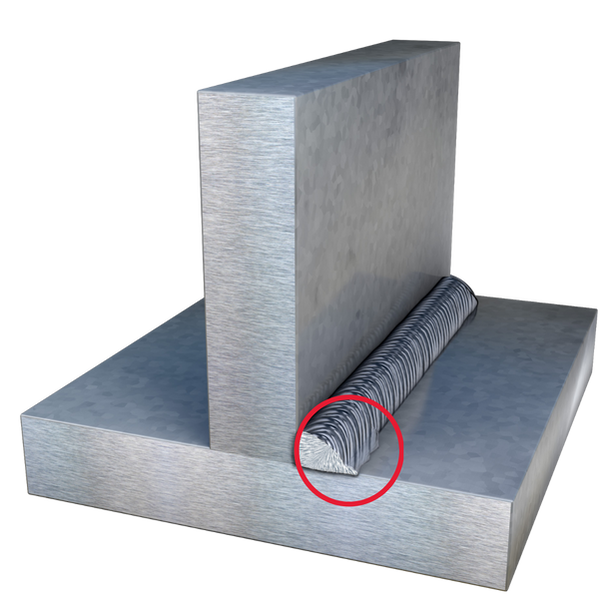Professional Methods for Preventing Weld Undercut Successfully
Professional Methods for Preventing Weld Undercut Successfully
Blog Article
Comprehending the Causes and Solutions for Undercut Welding in Metal Fabrication Processes
In the realm of metal manufacture procedures, the incident of undercut welding postures a considerable challenge that demands a detailed understanding of its causes and feasible services. The detailed interplay of numerous variables during welding operations can lead to this undesirable sensation, affecting the architectural integrity and total top quality of the bonded joints - Preventing weld undercut. By exploring the origin causes of undercut welding and exploring effective remedial steps, fabricators can elevate the standard of their workmanship and guarantee the production of remarkable steel components
Common Reasons of Undercut Welding
Regularly neglected in steel fabrication, undercut welding occurs due to numerous aspects that demand meticulous focus and know-how to be efficiently mitigated. One typical root cause of undercut welding is extreme heat input. When the warmth input is too expensive, it can cause the melting and subsequent erosion of the base product along the sides of the weld joint, producing a groove or undercut. Additionally, incorrect welding strategies, such as using the wrong welding angle or take a trip rate, can additionally contribute to undercut formation. Inadequate protecting gas insurance coverage is an additional vital factor that can result in undercutting. Not enough gas coverage fails to safeguard the weld pool sufficiently, causing oxidation and undercut problems. The choice of welding parameters, such as voltage, present, and cable feed speed, plays a significant duty in the event of undercut welding. Comprehending these typical reasons is crucial for applying safety nets and making certain high-grade welds in metal manufacture processes.
Impact of Incorrect Welding Parameters
Incorrect welding criteria can considerably endanger the integrity and top quality of welded joints in metal construction procedures. The influence of incorrect welding criteria materializes in numerous methods, leading to architectural weak points and issues in the welded elements. One important element impacted by improper welding specifications is the penetration deepness of the weld. Insufficient warm input because of low welding currents or excessively high travel rates can result in poor blend in between the base steels, causing incomplete joint penetration and compromised bonds. On the other hand, extreme warm input triggered by high welding currents or slow travel speeds can cause too much and burn-through support, creating a fragile and unstable weld structure. Furthermore, incorrect criteria such as incorrect voltage setups or wrong electrode angles can contribute to unpredictable weld bead profiles, lack of combination, and enhanced chances of flaws like damaging. For that reason, precise attention to welding parameters is paramount to make certain the production of high-grade welds with the preferred mechanical residential properties and structural integrity.
Impact of Improper Torch Angle
Improper lantern angle in welding procedures can considerably affect the top quality and integrity of the last weld joints in metal fabrication procedures. Undercutting is an usual welding problem where a groove forms along the weld toe, deteriorating the joint and endangering its architectural honesty.
A torch angle that is also steep can lead to insufficient penetration, insufficient combination, and enhanced spatter. On the other hand, a lantern angle that is also superficial can cause too much penetration, burn-through, and distortion of the base product. Preventing weld undercut. Proper lantern angle is necessary for guaranteeing regular weld high quality, strength, and look
To stop undercutting and various other issues triggered by inappropriate torch you could try these out angles, welders need to be trained to maintain the correct lantern angle throughout the welding procedure. Regular tracking and change of lantern angles throughout welding can assist attain audio welds with very little flaws.
Duty of Inadequate Welding Methods

Another aspect of poor welding strategies is improper weld preparation. Insufficient cleansing of the base steels, wrong joint design, or insufficient edge prep work can all contribute to undercut welding. Moreover, insufficient shielding gas protection or utilizing Learn More the incorrect kind of gas can cause incomplete fusion and the formation of undercut issues.
To address the function of inadequate welding methods in metal manufacture procedures, it is vital to give detailed training for welders. Proper education on welding specifications, joint preparation, and shielding gas selection can aid avoid undercut welding and make sure high-quality welds in metal construction tasks.
Effective Solutions for Undercut Welding
Attending to undercut welding in steel link fabrication needs applying effective solutions to enhance weld quality and architectural integrity. Among the primary services to deal with undercut is to readjust welding criteria such as voltage, present, and travel speed to make certain correct warm input and fusion. By fine-tuning these settings, welders can prevent extreme melting of the base steel and filler material, lowering the likelihood of undercut development.
In addition, appropriate joint preparation is crucial in avoiding undercut. Making sure clean base metal surface areas cost-free of pollutants and using the suitable bevel angle can assist advertise much better weld penetration and decrease the danger of undercut - Preventing weld undercut. Utilizing suitable welding strategies, such as oscillating the lantern or weaving, can likewise help in distributing heat evenly and filling up the weld joint effectively, minimizing the possibility of undercut flaws
Moreover, selecting the proper welding consumables, including electrodes and filler steels, is essential in alleviating undercut. Utilizing materials with proper chemical structures and mechanical buildings can add to achieving sound welds with minimal undercut. Regular evaluation and top quality control actions must additionally be executed to discover and address undercut concerns immediately, ensuring the general integrity of fabricated steel elements.

Conclusion
Finally, recognizing the reasons and services for undercut welding in metal construction processes is vital for achieving premium welds. By addressing typical causes such as inaccurate welding specifications, inappropriate lantern angle, and poor welding strategies, welders can protect against damaging and make sure strong, long lasting welds. It is crucial to take note of these variables and implement effective services to improve the overall welding process and final product top quality.

Report this page